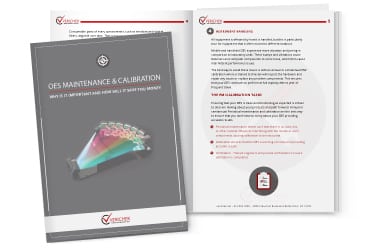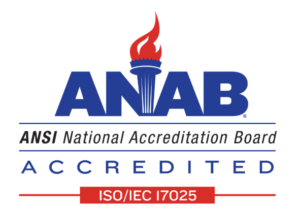Verichek receives requests for additional information about OES maintenance and potential problems with their spectrometers not functioning as expected. It is possible that you can avoid emergency repairs or make do repairs until a repair technician can be scheduled by following some common trouble shooting procedures.
The following are a few of the most common problems you can trouble shoot organized by the type of problem.
Vacuum Pump
What is the importance of spectrometer’s vacuum pump?
The vacuum pump purges the optic chamber so that the low wavelengths can pass through the atmosphere. Because of this, the vacuum pump is a critical component, and if it is not functioning as intended, it will adversely affect the test results.
Low wavelengths, such as those in the ultraviolet portion of the spectrums, cannot effectively pass through normal atmosphere.
What other potential problems can occur from a vacuum pump that is not functioning as intended?
A malfunctioning pump will cause the atmosphere to be introduced into the optic chamber, causing the low wavelengths to lose intensity or entirely disappear. The loss of intensity results in incorrect values for the measuring of elements in the lower wavelength spectrum. Lower wavelength elements include some of the most common and crucial elements to be measured including:
- Carbon
- Phosphorus
- Sulfur
- Nitrogen
What are the symptoms that a spectrometer’s pump needs maintenance?
Some models provide the information so you can request maintenance services before you encounter problems.
If your current model does not include early warnings for the pump, there are a couple of warning signs that will let you know there is a potential problem with your pump.
- Monitor for constant readings below normal levels for carbon, phosphorus, and sulfur. Since these elements are affected by the atmosphere, consistent readings below the norm mean that the pump probably is not functioning properly.
- If the pump is smoking, is hot to the touch, is extremely loud, or is issuing gurgling noises, there is almost certainly a problem with it.
- Pumps leaking oil require immediate replacement. Do not ignore this problem as it can create other issues.
Window Cleanliness
What or which window needs to be cleaned on a spectrometer?
There are two windows that require regular cleaning.
- The first window is located in front of the fiber optic
- The second window is located in the direct light pipe.
How does a dirty window affect a procedure or the results?
If these windows are dirty, instrument analysis can drift more often, resulting in a need for more frequent recalibration. It can also result in a very poor analysis reading.
How to troubleshoot a dirty window?
Troubleshooting is easy as you just need to clean the windows, or schedule regular maintenance to have the windows cleaned.

Download Our FREE OEs Maintenance & Calibration Guide
Why is it important and how will it save you money
Lens Alignment on Probes
What this mean?
Lens must focus on the source of the light’s origins. It is similar to using a flash to take a picture, but having the flash aimed in a direction other than the object or person that you are trying to take a picture of.
If the lens is not properly aligned, the light you want to collect will not return to the instrument.
Are there other problems with improper lens alignment?
The light being collected will not be intense enough for accurate results.
Since the instrument is meant to measure light intensity, an inadequate amount of light will result in highly inaccurate readings.
How to troubleshoot spectrometer lens alignment?
Operators can be trained to perform simple fixes as part of regular maintenance and basic operation. Typically, lens alignment is an easy task to perform. Operators can also be trained to recognize when a lens needs to be replaced.
Contaminated Argon
What are the symptoms of contaminated argon?

How do contaminated samples affect the procedure or result?
The problem with the results can range from being inconsistent to unstable. These results are affected by the machine analyzing both the material and the contamination the machine process added to the material.
How to troubleshoot contaminated samples?
- Collect the samples and use a new grinding pad to regrind them. This removes the plating, carbonization, or protective coatings before starting the analysis.
- Ensure the samples are not re-contaminated by not quenching them in water or oil. Do not touch the sample with fingers either as skin will add oil and grease contamination to the sample.
Probe Contact
What are the symptoms of probe contact?
The probe may not be correctly contacting a surface if the sound from the metal analysis is louder than you are accustomed to hearing and there is a bright light escaping from the pistol face.
How does incorrect spectrometer probe contact cause problems?
If a probe is not correctly contacting a surface, the results may be incorrect, or you may not get any results.
The instrument may provide a few different warnings that this problem is occurring, including the poor results or a lack of engagement with the software. The latter is the most likely result.
If the probe is not fully engaged and the software still recognizes it, it can cause high voltage to discharge inside the connector. This is not only potentially expensive to repair, it is very dangerous.
How to troubleshoot incorrect spectrometer probe contact?
- Increase the argon flow from 43pst to 60 psi.
- Add seals for convex shapes.
- Ask a Verichek Technical Service, Inc. repair person to custom build a pistol head to accommodate the contours of the surface.
Inaccurate Analysis Results
How can you tell if a spectrometer’s analysis results are inaccurate?
If you find results greatly vary between each test on the same sample, there is a problem with the results. There should not be significant variation for results of the same sample.
How to troubleshoot inaccurate analysis results from a spectrometer?
- Prepare the recalibration sample by grinding or machining it as flat as possible.
- Navigate to the recalibration problem in the spectrometer software (either IE FE100 or Al000).
- Follow the specific sequence prompted by the software. Do not deviate from the sample required by the software’s sequence.
- Analyze the first sample in the recalibration process five times in a row using the same burn spot.
The relative standard deviation (RSD) of any recalibration standard being analyzed should not exceed 5. If 5 RSD is exceeded, delete the analysis results and retry the process from step 1.
How to troubleshoot incorrect spectrometer probe contact?
- Increase the argon flow from 43pst to 60 psi.
- Add seals for convex shapes.
- Ask a Verichek Technical Service, Inc. repair person to custom build a pistol head to accommodate the contours of the surface.

Download Our FREE OEs Maintenance & Calibration Guide
Why is it important and how will it save you money

